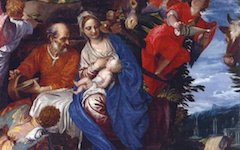Veronese’s The Marriage at Cana (1563)

Veronese, Marriage at Cana or Wedding Feast at Cana (1563) Oil on canvas. 666 x 990 cm. Louvre, Paris
Click image to enlarge.
Veronese's Marriage at Cana is one of those paintings so large and so important that no history of art can be complete without tackling it. It supposedly depicts the moment when drink ran out at a wedding feast and Christ miraculously turned the water into red wine. Despite its importance, only artists have ever seen what is happening.
Click next thumbnail to continue
In the foreground Titian (in red) and Veronese (in white) play stringed instruments like the cherubs at the base of earlier 16th-century altarpieces. As in examples by Carpaccio (1510) and Titian (c.1550), the performing musicians are alter egos of the artist painting the rest of the image. In this example Veronese makes it more obvious by depicting the musicians as famous painters, one of them himself.
Click next thumbnail to continue
In addition, all the by-standers are the artists' studio assistants busily struggling to paint the scene. The theatrical staging, often noted by critics, helps emphasize this.1 There is, though, an additional disparity between the perspective of the dining-table and that of everything else. The principal viewpoint is at the level of the marble balustrade half-way up the painting. The greatly foreshortened dinner-table, though, is seen from only slightly above it thereby confirming its own reality as the painting within the painting.
Click next thumbnail to continue
That is also why Christ stares heiratically out of the painting looking like a painting.2 In fact, the scene intentionally resembles Leonardo's iconic Last Supper. If this were an illustration of the biblical story, as always supposed, Christ would interact with the other guests. Nor would he be at the center of the table where the bride and groom ought to be seated.
Click next thumbnail to continue

Left: Detail of Christ's face from Veronese's Feast in the House of Simon (1563)
Right: Detail of Veronese's Self-portrait (c.1558-63)
Click image to enlarge.
I do not have a good reproduction of Christ's face in Marriage at Cana for comparison but you can see from the proportions, the hair coloring, the moustache and other facial features of Christ in another of Veronese's canvasses that he identified with him. The introduction to the theme Artist as Christ also helps explain how Christ is the divine spark in the mind of any great master in the Renaissance and beyond.
See conclusion below
In the Marriage at Cana Veronese depicts his own mental processes during the conception of the painting itself using the theater as a visual metaphor for the artist's workspace. I should add that on the balcony some figures use knives to cut up meat instead of paintbrushes and rest their arms on staffs instead of mahlsticks. The underlying concept is that all the figures are variations of Veronese's own persona or self because the scene we see is inside him.
More Works by Veronese
Notes:
1. Claire Constans and Jean Habert have noted that Veronese's Christ figures "are all given the same physique and a heiratic pose at odds with the naturalism of the other actors." "Maestoso Teatro" in The Feast in the House of Simon - Veronese - History and Restoration of a Masterpiece (Paris: Alain de Gourcuff) 1997, p. 27
2. ibid. p.35
Original Publication Date on EPPH: 15 Apr 2012. | Updated: 0. © Simon Abrahams. Articles on this site are the copyright of Simon Abrahams. To use copyrighted material in print or other media for purposes beyond 'fair use', you must obtain permission from the copyright owner. Websites may link to this page without permission (please do) but may not reproduce the material on their own site without crediting Simon Abrahams and EPPH.




